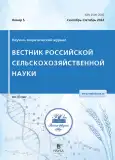Продуктивность и адаптивные свойства сортообразцов картофеля различного происхождения на юге Дальнего Востока
- Авторы: Ким И.В.1, Клыков А.Г.1, Волков Д.И.1
-
Учреждения:
- ФГБНУ «ФНЦ агробиотехнологий Дальнего Востока имени А.К. Чайки»
- Выпуск: № 5 (2024)
- Страницы: 26-33
- Раздел: Растениеводство и селекция
- URL: https://vestnik.nvsu.ru/2500-2082/article/view/659242
- DOI: https://doi.org/10.31857/S2500208224050061
- EDN: https://elibrary.ru/ztjikp
- ID: 659242
Цитировать
Полный текст
Аннотация
Представлены результаты изучения продуктивности генотипов картофеля различного происхождения в зависимости от влагообеспеченности почвы, в том числе гидротермического коэффициента (ГТК). Отмечено, что у среднеспелых сортов она максимальная – 710 г/куст. Сильное переувлажнение почвы (ГТК = 2,5 и более) во время вегетации, особенно в фазе клубненакопления, негативно влияет на формирование продуктивности. Высокие результаты по данному показателю получены в относительно благоприятные по погодным условиям годы – 2019, 2021, 2022 (индекс условий среды (I) варьировал в пределах 201,63–221,35), когда средняя продуктивность всех образцов составила 950 г/куст. В 2015–2018, 2020 и 2023 годах были очень низкие показатели – 420–670 г/куст из-за высокой переувлажненности почвы (I = -99,52 – -269,81). Выделены генотипы, которые в совокупности с повышенной продуктивностью (более 900 г/куст), имели высокую отзывчивость на изменение условий среды и стабильность (средние показатели bi = 1,49, S2d·103 = 0,42): раннеспелые – Антонина, Бастион, Колымский, Крепыш, Матушка, Метеор, Памяти Кулакова, Удача, Vitesse, Red Lady, Red Scarlett; среднеранние – Арктика, Бриз, Зоя, Камчатка, Лилея, Чародей, Gala; среднеспелые – Очарование, Утро, Фаворит; среднепоздние и поздние – Казачок, Победа. Выделены сортообразцы с высокими показателями продуктивности (1040–1480 г/куст), товарности (83,2–92,8%), пластичности (bi = 1,20–1,85), стабильности (S2d = 0,15–5,77), гомеостатичности (Hom = 9,51–40,62) и селекционной ценности (Sc = 532,79–852,14) в условиях юга Дальнего Востока: раннеспелые – Бастион, Колымский, Крепыш, Памяти Кулакова; среднеранние – Арктика, Зоя; среднеспелые – Аляска; среднепоздние и поздние – Ветразь, Победа.
Ключевые слова
Полный текст
Об авторах
Ирина Вячеславовна Ким
ФГБНУ «ФНЦ агробиотехнологий Дальнего Востока имени А.К. Чайки»
Автор, ответственный за переписку.
Email: kimira-80@mail.ru
доктор сельскохозяйственных наук
Россия, п. Тимирязевский, г. Уссурийск, Приморский крайАлексей Григорьевич Клыков
ФГБНУ «ФНЦ агробиотехнологий Дальнего Востока имени А.К. Чайки»
Email: kimira-80@mail.ru
академик РАН
Россия, п. Тимирязевский, г. Уссурийск, Приморский крайДмитрий Игоревич Волков
ФГБНУ «ФНЦ агробиотехнологий Дальнего Востока имени А.К. Чайки»
Email: kimira-80@mail.ru
Россия, п. Тимирязевский, г. Уссурийск, Приморский край
Список литературы
- Жевора С.В., Анисимов Б.В., Симаков Е.А. и др. Картофель: проблемы и перспективы // Картофель и овощи. 2019. № 7. С. 2–7. https://doi.org/10.25630/PAV.2019.89.92.006.
- Жученко А.А. Эколого-генетические принципы мобилизации мировых генетических ресурсов высших растений // Образование, наука и производство. 2014. № 2. С. 9–17.
- Зейрук В.Н., Мальцев С.В., Васильева С.В., Бызов В.А. Современные производственные факторы, определяющие биологическую и экономическую эффективность хранения картофеля // Хранение и переработка сельхозсырья. 2019. № 3. С. 20–26. https://doi.org/10.36107/spfp.2019.177.
- Киру С.Д., Рогозина Е.В. Мобилизация, сохранение и изучение генетических ресурсов культивируемого и дикорастущего картофеля // Вавиловский журнал генетики и селекции. 2017. Т. 21. № 1. С. 7–15. https://doi.org/10.18699/VJ17.219.
- Киселев Е.П. Создание сортов картофеля для энергосберегающей широкорядной технологии возделывания картофеля на Дальнем Востоке // Дальневост. аграр. вестн. 2018. № 3 (47). С. 25–36. https://doi.org/10.24411/1999-6837-2018-13054.
- Лебедева В.А., Гаджиев Н.М., Иванов А.В. Продолжительность периода покоя клубней некоторых сортов картофеля и их гибридов в условиях Ленинградской области // Труды КубГАУ. 2020. № 85. С. 121–124.
- Логинов Ю.П., Казак А.А. Формирование надземной массы и урожайности клубней в зависимости от содержания крахмала в семенных клубнях среднеспелых сортов картофеля // Пермский аграр. вестн. 2018. № 4 (24). С. 72–76.
- Методические указания по поддержанию и изучению мировой коллекции картофеля / сост. С.Д. Киру, Л.И. Костина, Э.В. Трускинов и др. СПб., 2010. 30 с.
- Методическое положение (руководство) по оценке продуктивности и столовых качеств картофеля (кулинарный тип) / ФГБНУ ВНИИКХ; А.Э. Шабанов, Б.В. Анисимов, А.И. Киселев и др. М., 2017. 20 с.
- Неттевич Э.Д., Моргунов А.И., Максименко М.И. Повышение эффективности отбора яровой пшеницы на стабильность урожайности и качество зерна // Вестник сельскохозяйственной науки. 1985. № 1. С. 66–73.
- Подгаецкий А.А., Кравченко Н.В., Собран И.В. Средняя масса клубней потомства от беккросирования сложных межвидовых гибридов картофеля в первом клубневом поколении // Картофелеводство: мат. науч.-практич. конф. «Современное состояние и перспективы развития селекции и семеноводства», 9–10 июля 2018 г. ВНИИКХ. М., 2018. С. 71–78.
- Тимошкин О.А., Тимошкина О.Ю. Многолетние травы для создания газонов в условиях лесостепи Среднего Поволжья. Кормопроизводство. 2023. № 1. С. 12–15. https://doi.org/10.25685/KRM.2023.47.76.001.
- Хангильдин, В.В. О принципах моделирования сортов интенсивного типа // Генетика количественных признаков сельскохозяйственных растений / АН СССР, Науч. совет по проблемам генетики и селекции, Сиб. отд-ние [и др.]. М.: Наука, 1978. С. 111–115.
- Чайка А.К., Клыков А.Г. Приоритетные направления в развитии агропромышленного комплекса Дальнего Востока России // Вестн. ДВО РАН. 2016. № 2. С. 24–30.
- Чирко Е.М. Сравнительная оценка зерновой продуктивности и адаптивности сортов проса (Panicum Miliaceum) в условиях юго-западного региона республики // Весцi нациянальнай акадэмii навук Беларусi. Серыя агарных навук. 2009. № 3. С. 49–54.
- Шанина Е.П., Клюкина Е.М. Изучение исходного материала картофеля в условяих Среднего Урала // Агропродовольственная политика России. 2018. № 1 (73). С. 31–34.
- Шанина Е.П., Клюкина Е.М., Стафеева М.А. Сравнительный анализ сортов картофеля коллекционного питомника в зависимости от географического происхождения // Достижения науки и техники АПК. 2020. Т. 30. № 6. С. 75–78. https://doi.org/10.24411/0235-2451-2020-10614.
- Юрьева Н.О., Воронкова Е.В., Терешонок Д.В. и др. Введение в асептическую культуру дигаплоидов картофеля с использованием адвентивных побегов и химиотерапии // Защита картофеля. 2017. № 2. С. 2–27.
- Яшина И.М. Значение сорта в современных технологиях производства картофеля / Мат. науч.-практ. конф. «Картофель-2010». «Актуальные проблемы современной индустрии производства картофеля». Чебоксары, 2010. С. 41–44.
- Eberhart S.A. Yield stability of single-cross genotypes // Proc. of the 24th Annual Corn and Sorghum Industry Research Conf., Chicago, IL, 9–11. Dec. / J.I. Sutherland, R.J. Falasca (Eds.). Chicago, 1969. P. 22–35.
Дополнительные файлы












